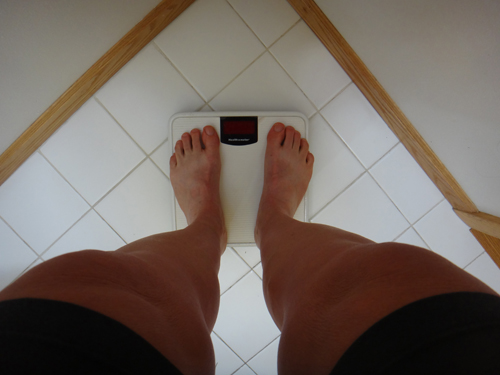Strength-to-weight ratio

The fine line between reaching one’s potential or breaking down
By Kierstin Kloeckner
There is a buzz phrase you’ll hear amongst most competitive cyclists, climbers and runners… the ideal strength-to-weight ratio. For most of these athletes, this is their ultimate goal. Find the line – the very thin line – between essentially going into starvation mode or becoming almost machine in nature.
I grew up heavily-steeped in the bike racing scene throughout the ’80s and ‘90s. It was during this time the way people ate, trained and viewed their bodies changed. During the ‘70s, ‘80s and ‘90s, it wasn’t uncommon for cyclists to gain 10-15 pounds over the winter. My dad, who began racing in 1972, did it every year. Like clockwork, the state road and criterium championships would end and he allowed himself to relax a bit. Sure, he’d still ride five, six days each week, and over the winter he’d speed skate, cross country ski or run to keep his cardio base up, but overall, he considered his training to be over until the following spring.
Growing up, I remember all of this distinctly. He would have an extra beer after work, allow himself a little more junk food and while I could easily count his ribs through his back during the summer, over fall and winter he’d look… shall we say “healthier.” To this day, I know my dad’s ideal strength-to-weight ratio. At 6 foot 1 inch, he knew he was race ready between the weight of 165-167lbs. Drop a couple pounds below and he’d get a cold (like clockwork); weigh in a bit heavier and he’d be off the podium. But here’s my question, how much of this was physiological and how much was psychological?
Fast forward to the present. As I sit and watch the 2016 summer Olympics, and have my eyes glued to the women’s road race, I’m not so sure how I feel about Mara Abbot. Here is this unbelievably talented and strong 30-year-old woman, on the brink of breaking down, and we are all cheering for her. In a recent interview, Mara admitted to a long-term struggle with exercise anorexia. She states her first round was brought on because she wanted to stop racing and this was the only way she knew how to take herself out of the sport. Here’s the thing, she came back to racing, put on a little bit of weight, and still, she says, she struggles with the disease. And yet, every comment I hear, especially from men (sorry guys), is how strong she looks and how she has the perfect strength-to-weight ratio for a road racer. I want to scream, “Look at her! She doesn’t look strong! She looks as if she were to lose another couple pounds, she’d be hospitalized.” No, I’m not her doctor, but I do know a fair amount about this.
Step back to 1984. I was ten at the time. All I could think about was bike racing. During the winter I’d watch old videos of the classics with my dad, during the spring and summer I’d go out on road rides with my dad and each weekend I’d follow him around the Midwest to his races. I’d study each race, applying the tactics he taught me, seeing if who I predicted to win, would actually win and why. Other than music, cycling was my life. I couldn’t wait to be on a junior team and train my heart out. I couldn’t wait to be on the podium, like my dad.
The trouble with childhood obsessions is they can get out of control very quickly if not monitored. Kids take things more seriously than most parents like to believe. When my father told me at age 11 I’d need to lose some weight to become a stronger cyclist (I was going through the all-too-common prepubescent weight gain at the time), I decided to change. All the talk around strength-to-weight ratio didn’t really exist back then, and junior female racers were almost non-existent. Although there were a few female coaches, even they didn’t know how to train the female youth body. My dad certainly didn’t know. All I knew was, if I wanted to compete, I have to lose weight.
At first, I began limiting my junk food and riding a bit more. Neither of these actions were bad, but the thinking behind it was. I had no desire for “health,” per se, just a lower weight. Then, I began skipping meals and fitting things like jumping jacks into every open spot of the day. By the age of 12, I looked completely different. I may have looked healthy since I was certainly lean and muscular (I remember competing against my P.E. teacher for the highest number of pushups and I was the only girl who opted to do pull ups versus the flexed arm hang), but, essentially, I was on the brink of breaking down. A couple months later, I would be hospitalized and threatened to be tube fed if I didn’t start eating. My mom was the one who finally took charge and forced me into an inpatient program at Methodist hospital in Minnesota. My weight, I think at the time, was 73 pounds. The doctors told me my internal organs were essentially being eaten and used as fuel to keep my brain alive. Part of me knew I was unhealthy and no longer strong, but once the addiction begins – just like alcoholism – rarely can it be broken alone, since the brain no longer functions properly.
Thankfully, because my issues were caught so quickly, a few months of inpatient help and a few years of outpatient care reversed my way of thinking and was actually what initially got me on the path I’m on today, providing personal training to others. After getting strong enough, I was given the green light to ride and race again (but under close supervision). The thing is, when you’re surrounded by obsessive behavior of any sort, it’s easy to slip back. Although I never fell back completely in my old ways, I began to notice a few things about myself I only truly began to understand within the last 15 years. First, I didn’t really like riding with extremely-competitive racers. With them, I always felt inadequate and I would often slip into unhealthy ways of thinking about myself. Instead, I usually opted to ride with a couple of my fellow junior team members who liked to just go out and explore (i.e., often get lost) on two wheels. Sure, we’d push each other and ride hard at times, but the end goal was to have fun, not win. This way of thinking is what has kept me in cycling for so long.
Let’s move back to the present. As a trainer, a coach and a friend to so many competitive cyclists/athletes, I deal with the fine line of reaching one’s true potential or breaking down on almost a daily basis. Don’t get me wrong, although I found racing wasn’t for me, I have nothing against it. I do, however, have great issues, and this is speaking as a coach, with unhealthy ways of training.
Guess what folks… THERE IS NO MAGIC NUMBER! Sometimes, being a couple pounds heavier than you think you should be keeps you strong in both mind and body, while sometimes, we are able to drop below a specific weight to help us achieve our goals for an event. The trick, however, is being able to understand one’s body in both a micro and macro way. To be able to recognize how you feel from day to day and over the long run when certain changes are made (diet, weight, sleep, training, etc.) without becoming obsessed. Take Lance Armstrong, for example (aside from his doping). Yes, he won and brought a new level to training and competing, but at what cost? He weighed out every gram of food and stuck to his training plan to a “T” – it didn’t matter if he felt like having ice cream once in awhile, if it wasn’t on the plan, he just wouldn’t do it. And with that may come a machine-like body, but also a very sick mind. We, as humans, are organic. We are meant to be pliable in both mind and body. We are not meant to be fixated on only one thing. If you’ve ever been in that spot for too long, you know it’s not sustainable.
So here’s my plea. As a trainer, coach, friend of athletes and athlete myself, I beg of you to think about all of this and decide how you want your kids to grow up, what example you want to make as an athlete, and what makes you feel healthy (no matter what your coach or any other athlete says). Take notes from day to day if you want. Study them over a long period of time – a year or several years versus a season. See what works for you and what makes you feel most balanced, not just what earns you a podium spot.
*Recently, Mara decided to call pro bicycle racing quits. The media links most of her struggle with low pay, but I can’t help but think about the toll racing took on her body and how, maybe, she had to call it quits because her body didn’t want to do it anymore.


